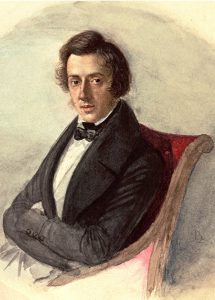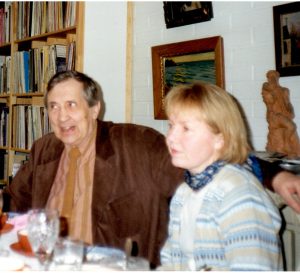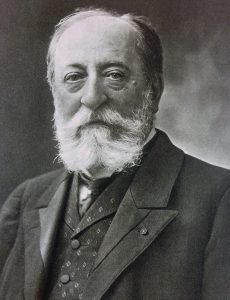
Maria Wodzinskan kuva Chopinistä v. 1836. (Teoksesta Mieczysław Tomaszewski: Chopin. Kraków: PWM Edition.)
♦ Chopin-yhdistyksen resitaali Balderin salissa Helsingissä 17.10.2021
Kaikissa kunnon valtioissa on tietenkin Chopin-seura, jollainen Suomeen perustettiin v. 2003; sitä johtaa Hui Ying Tawaststjerna. Se järjestää pianotapahtumia, nyt oli vuorossa Janne Mertanen. Hän on niitä pianisteja, joiden nimen tarvitsee vain ilmaantua konserttikalenteriin, niin tulee tunne: tänne täytyy mennä. Hän on jo julkaissut useampia mestarillisia Chopin-levytyksiä mm. Joensuun orkesterin kanssa, mutta häntä on parasta kyllä kuulla livenä – kuten olisi ollut Chopinin oman soitonkin kanssa. Balderin sali toimi oivallisesti ’salonkina’, jossa Mertanen soitti valikoiman Chopinin teoksia: kaksi impromptua, kaksi nokturnoa, neljä masurkkaa, poloneesin cis-molli ja huipennuksena Barcarollen Fis. Hänen tulkintansa olivat juuri niin ilmeikkäitä kuin pitääkin olla; ohjelman yksi huippuja oli nokturno Des-duuri, jossa piano lauloi ja fraseeraus oli kuin puhuvaa musiikkia – mitä Chopinin oma opettaja Josef Elsner jo aikoinaan korosti. Valikoima edusti juuri niitä lajeja, jotka Chopin oikeastaan itse loi ja joissa hän oli mestari. Mertanen ei vain hallitse sfogaton finessejä, vaan antaa musiikin kasvaa myös forteen; Chopinin oma soitto operoi pianissimon kvaliteeteilla, mutta kun hän kirjoittaa em. nokturnoon kolme f:ää: fff, niin kyllä se sitä tarkoittaa.
Nyt kokoan tähän muutamia ajatuksia Chopinin musiikista suppeaksi opastukseksi tämän säveltäjän tulkintaan. Olen häntä tutkinut jo kuudessa esseessä, joista tunnetuin on ehkä analyysini G-molli balladista (mm. A Theory of Musical Semiotics -kirjassani 1994, myös suomeksi Musiikkitiede-lehdessä ja se on muistaakseni käännetty puolaksikin; sitä paitsi puolalaiset kollegani sen hyväksyivät ja mainitsevat omissa julkaisuissaan kuten myös musiikin teoreetikko Juri Holopov Moskovasta). Kiteytän oppaani seuraaviin kohtiin:
Chopin, puolalainen: Chopin on Puolan symboli ja ikoni siinä missä Sibelius Suomen. Mutta Puolaa ei ollut maana enää olemassa, kun Venäjä, Itävalta ja Preussi jakoivat sen 1795. Kansallishenki ei silti kuollut. Noch ist Polen nicht verloren! V. 1830 nousi vallankumous miehittäjiä vastaan, se epäonnistui ja suuri määrä intellektuelleja pakeni maasta. Monet Pariisiin kuten Chopin – ja Puolan kansallisrunoilijaksi kohonnut Adam Mickiewicz. Häneen Chopinia mielellään verrattiinkin; sanottiin, että Chopin oli ”pianon Shakespeare, Byron ja Mickiewicz” (tosin Chopin ei itse pitänyt Shakespearesta). Tätä aihepiiriä on tarkastellut jyväskyläläinen pianisti Matti Asikainen hienossa esseessään ”Chopinin ’mickiewicziläiset’ balladit G-molli ja F-duuri: Genre ja ohjelmallisuus” (Synteesi 1-2/1991). Mickiewicz harmitteli, että Chopin kirjoitti ’vain’ pianolle, hän odotti suurta kansallista oopperaa.
Chopinin musiikki ei ole kuitenkaan koskaan ohjelmallista. Jälkeenpäin se on kyllä virittänyt onia kirjallisia kuvailuja, päinvastoin kuin Liszt, jolla ohjelmat olivat ennen sävellystä. Sen sijaan puolalaisuus on läsnä kaikkialla Chopinissä. Se on tuo Lisztin analysoima zal, joka tarkoittaa syvää surua ja valitusta – vähän niin kuin saudade Brasiliassa tai pohjoinen melankolia Griegillä tai Sibeliuksella. Mutta jos Pariisin salongissa kysyi, mitä tuo puolan sana zal oikein tarkoitti, sai vastaukseksi: Oi, sitä ei voi kääntää. Il est intraduisible (Liszt s. 115).
Chopin, pianisti: parhaan kuvan tästä roolista saa sveitsiläisen Jean-Jacques Eigeldingerin teoksesta Chopin vu par ses élèves (Neuchatel 1979). Kaikki lähti Chopinin soitossa analogiasta musiikin ja kielen välillä. Tosin hän kauhisteli liioteltua aksentointia, liian voimakas soitto oli ’saksalaista’ (s. 88), hänen fortensa oli suhteellista, ei absoluuttista. Yksinkertaisuus oli keskeinen hyve, eikä hän koskaan soittanut samaa teosta kahdesti samalla tavalla. On paljon detaljeja, jotka täytyy oppia Chopin-tradition haltijoilta: kuten trioli vs. pisteellinen kuudestoistaosa – muuttakaa kuudestoistaosa trioliksi: vanha klavesinistien koulu (Timo Mikkilän opetus, esim. Poloneesi-fantasian lopussa); appoggiaturat aina iskullisina, ei etuheleinä. Jne. Opettajana hän kyllä käytti harjoituksia kuten murrettuja vähennettyja septimisointuja yli klaviatuurin. Älkää aloittako C-duurista, hän neuvoi, vaan E-duurista: siinä pitkät sormet joutuvat luontaisesti mustille koskettimille. Opettajana hän kunnioitti oppilaiden yksilöllisyyttä: ”Kun olette pianon ääressä, annan teille täyden vallan tehdä mitä haluatte, seuratkaa vapaasti ihannettanne, jonka olette luoneet ja jonka tunnette omaksenne.” Oppilaan oli tunnettava itsensä vapautuneeksi. Tässä siis Chopin erosi jyrkästi ns. ranskalaisesta ja venäläisestä autoritäärisestä pedagogiasta.
Chopin, säveltäjä: tämä kategoria kasvaa orgaanisesti edellisestä eli soittamisesta ja ylipäätään esittämisestä. Tiedetään, että Chopin ihaili bel cantoa yli kaiken ja kuuli jo Varsovassa ja sitten Pariisissa suuria italialaisia tähtiä Rubinia, Malebrania ja Pastaa. Hän oli Bellinin Puritaanien ensi-illassa 1835 Pariisissa ja seurasi Normaa. ”Casta diva” oli hänen melodinen ihanteensa (ja saattaa olla, että myös Bellinin niukka orkestraatio, vrt. pianokonsertot). Hänen puolalainen kollegansa Woyciechowski kuvaili Rubinin laulua Pariisissa 12.12.1831 seuraavasti: 1) mahtava ääni, ei falsetto-rekisteriä 2) pitkät ’rouladet’ eli koruilut, 3) runsas, joskus ylitsevuotava koloratuuri, 4) tremolot ilmaisevassa tarkoituksessa, 5) spektakulaarisen pitkät trillit ja 6) verraton mezza voce. Kaikki nämä piirteet siirtyivät Chopinille, joka myös tunsi kauden suuren laulutaiteen traktaatin: Garcian Traité complète de l’art du chant (ilmestyi Pariisissa 1844). Siinä on kuvattu kaksi tyypillistä Chopinin tyylilajia: tempo rubato ja canto spianato. Rubatoa oli kahta lajia: joko melodista, jossa säestyksen soinnut olivat ankarasti rytmissä tai rakenteellista ts. koko tekstuuria kiirehdittiin tai hidastettiin. Andante spianato on täydellinen esimerkki näistä ilmaisuista.
Chopinin musiikki toteuttaa yhtä kaikki ranskalaisen kirjallisuusteorian käsitettä énonciation énoncée, lausuttu lausuminen eli: lausuminen = tulkinta, soitto; lausuttu = partituuri ts. esittäminen, joka on jo kirjoitettu nuotteihin. Sfogato oli tuli italian sanasta foga, intohimo ja ’s’ tarkoitti sen purkautumista. Ts. sfogare-verbi on yhtä kuin tunteenpurkaus. Franz Liszt kirjoitti tunnetun kirjasen Chopinistä tämä kuoleman jälkeen; siinä Liszt kuvaili näitä sfogatoja. Mm. masurkoissa ilmeni… ”tanssia, huokauksia, kyyneliä, ahdistusta, salaisuuksia, tukahdutettuakauhua,valituksia, rakkautta, joka taistelee ja säilyy, ja ilmenee säälinä, mutta myös hulluuden kiihkoa, jossa ilmenee epäröivä melodia, kuin tykytyksiä sydämessä, joka kuolee rakkauteen ja etäisiä fanfaareja, kaukaisia muistoja kunniasta, määräämättömiä rytmejä, jotka ovat verrattavissa nuorten rakastavaisten tapaan katsella tähtiä…”(Liszt s. 57) Miten nämä romantikot olisivatkaan nauraneet, jos olisivat kuulleet puhuttavan jostain ’sisällöntuotannosta’ kuten meidän aikanamme. Musiikki oli heille yhtä kuin sisältö.
Charles Rosenin monumentaaliteoksessa The Romantic Generation on tietenkin luku Chopinille, joka alkaa haastavalla alaotsakkeella ”Folk Music”? Rosenin mielestä Chopinin tapa käsitellä kansanmusiikkia ennakoi jo sitä, miten Debussy viittaa espanjalaisen musiikkiin. Hän käyttää vain melodian fragmentteja ja tyypillisiä puolalaisia rytmejä. Masurkka on itse asiassa monimutkainen rytmikuvio, jossa aksentti vaihtelee viidellä eri tavalla, onko se alussa, lopussa vai keskellä tahtia ja mikä on sävelten rytminen tiheys (ks. Ewa Dahlig-Turekin essee Mazurka. Before and after Chopin antologiassa Chopin 1810-2010.) Kaikki kolmijakoisen rytmin puitteissa. Erityisen puolalaiselta kuulostaa: // / / – taustalla on poloneesi ja kujawiak. Olennaista on, että näistä itse luomistaan lajeista Chopin päätyy ns. synkreettiseen tyyliinsä myöshäisteoksisaan, joissa hän yhdistelee kyseisiä elementtejä ts. masurkkoja, nokturneja, scherzoja, valsseja, poloneeseja ja impromptuja (esim. f-mollifantasiassa, Poloneesi-fantasiassa, f-molliballadissa jne).
Chopin, ihminen. Chopinista on lukuisia maalauksia, akvarelleja ja piirustuksia – ja jopa yksi daguerrotypia, joista saa selvän kuvan miltä hän näytti. Ehkä kuuluisin on hänen ystävänsä Eugène Delacroix’n maalaus, joka on nyt Louvressa. Näitä kuvia on nähtävillä mm. Mieczysław Tomaszewskin, legendaarisen lähes 100-vuotiaaksi eläneen Chopin-spesialistin sekä professori Irena Poniatowskan loisteliaissa kuvakirjoissa.
Liszt sanoi hänestä (lainaten Sandia): ”Hän puhui vähän eikä lainkaan kuunnellut, eikä halunnut ilmaista ajatuksiaan kuin vasta kun ne olivat kypsyneet tietylle tasolle” (Liszt s. 134). Ehdottomasti vakuuttavimman ja todenmukaisimman kuvan Chopinistaantaa George Sand, jonka kumppani hän oli peräti seitsemän vuotta. Sandin kannalta se oli pisin aika, mitä hän seurusteli kenenkään miehen kanssa, joita oli monia. Heidän epäonninen matkansa Mallorcalle on kaikkien tuntema. ”Chopin oli jähmettynyt eräänlaiseen rauhalliseen epätoivoon ja soitti suurenmoisen preludinsa itkien. Hänen neronsa oli täynnä mystisiä harmonioita, jotka hän käänsi musiikillisen ajattelunsa ylevälle kielelle. Chopini nerous oli syvin mahdollinen ja täynnä tunteita, mitä on ikinä ollut. Hän pystyi yhdellä instrumentilla soittamaan äärettömän kieltä… Tarvitaan suurta maun ja intelligenssin kehitystä ennen kuin hänen teoksena voivat tulla populääreiksi ”(Sand s. 41, 420 et passim). Chopin oli sietämätön sairaana ja lopulta molemmat toivoivat vain pääsevänsä pois saarelta. Nohantissa, Sandin linnassa, Chopin viihtyi ja ei viihtynyt. Hän oli maailman mies, ja hänen maailmansa oli parhaimmillaan noin kahdenkymmenen hengen salonki. Jos hänen luonteensa oli täynnä tuota melanlolista zalia, se oli outoa Sandille. Chopin pysyi täysin vieraana Sandin pyrinnöille, tutkimuksille ja vakaumuksille, koska oli sulkeutunut katolisiin dogmeihinsa. Resignaatiosta Sand sanoi: se ei ole minun luonteessani, en tunne tuota synkkää surullisuutta (hieman myöhemmin Richard Wagner sanoi Cosimalle: Yleisin kansakunta on Resig-nation). George Sand piti tuollaista alistumista itsekkyytenä, sillä hänen periaatteensa oli: Ei mitään kunnianhimoa tai henkilökohtaista onnea itselleni tässä maailmassa, mutta paljon toivoa ja onnen tavoittelua toisille (Sand s. 440). Sandin kuva Chopinista on realistinen, hänen kanssaan seitsemän vuotta eläneen naisen raportti (Historie de ma vie, Vème partie, chapitre XIII), vailla minkäänlaista mytologisointia.
— Eero Tarasti
Kirjallisuutta:
Matti Asikainen 1991. ”Chopinin ’mickiewicziläiset’ balladit g-molli ja F-duurti: genre ja ohjelmallisuus”. Synteesi 1-2/91, ss. 103-128.
Jean-Jacques Eigeldinger 1979 Chopin vu par ses élèves. Neuchatel: A La Baconniére.
Alfred Cortot 1949. Aspects de Chopin. Paris: Editions Albin Michel.
Franz Liszt 1963. Chopin. Paris: Nouvel Office d’Edition.
Irena Poniatowska 2009 Fryderyk Chopin. The Man and His Music. Warszawa: Multico.
Irena Poniatowska, Zofia Chechlinska (eds.), 2017. Chopin 1810-2010, 1-2. Ideas, Interpretations, Influence. Warsaw : The Fryderyk Chopin Institute.
Charles Rosen 1995. The Romantic Generation. Cambridge: Harvard University Press.
George Sand 1972. Oeuvres autobiographiques, II.Vie littéraires et intime 1832-1850. Histoire de ma vie. Paris: Gallimard, Bibliothèque de la Pleiade.
Mieczysław Tomaszewski 2009. Chopin. Olszanica, Poland: Publisher Bosz.
Eero Tarasti 1989. ”Chopinin g-molli balladin narratiivinen kielioppi”. Musiikkitiede 2/89, ss. 4-46.
— 1994. A Theory of Musical Semiotics. Bloomington: Indiana University Press.
— 2005. ”George Sand. Unohdettujen ääni”. Synteesi 3/2005, ss. 2-13.

